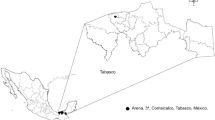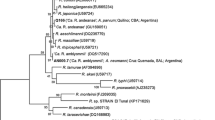Abstract
The tick species, Amblyomma neumanni (Acari: Ixodidae) is the most frequent tick parasitizing humans in northwestern Argentina. The present study evaluated the rickettsial infection among 55 A. neumanni adult free-living ticks collected in Dean Funes, Córdoba Province. Ticks were individually processed by the hemolymph test with Gimenez staining, isolation of rickettsia in Vero cell culture by the shell vial technique, and polymerase chain reaction (PCR) targeting the citrate synthase rickettsial gene. Through the shell vial technique, rickettsiae were successfully isolated and established in Vero cell culture from two ticks (ticks 4 and 13), which previously showed to contain Rickettsia-like organisms by the hemolymph test. These two Rickettsia isolates were designated as An4 and An13. Molecular characterization (partial DNA sequences of two to three rickettsial genes were determined) of these two isolates and phylogenetic analyses identified them as Rickettsia bellii (isolate An4) and Candidatus “Rickettsia amblyommii” (isolate An13). After testing all A. neumanni ticks by PCR, the prevalence of Candidatus R. amblyommii and R. bellii was 23.6% (13/55) and 3.6% (2/55), respectively. These two rickettsiae have been considered of unknown pathogenicity and appropriate studies to test their pathogenicity to humans or animals need to be conducted. This is the first report of Rickettsia in ticks from Argentina, and also in the species A. neumanni. The results reinforce previous findings that R. bellii (and probably Candidatus R. amblyommii) are widespread among some Neotropical Amblyomma species, suggesting that these ticks gained these bacterial agents from a common ancestor and/or by recent horizontal transmission of rickettsiae between ticks.



Similar content being viewed by others
References
Aguirre, DH, Vinabal, AE, Guglielmone, AA (1999) The life cycle of Amblyomma neumanni Ribaga, 1902 (Acari: Ixodidae) in the laboratory. Exp Appl Acarol 23: 159–164
Altschul, SF, Gish, W, Miller, W, Myers, EW, Lipman, DJ (1990) Basic local alignment search tool. J Mol Biol 215: 403–410
Blair, PJ, Jiang, J, Schoeler, GB, Moron, C, Anaya, E, Cespedes, M, Cruz, C, Felices, V, Guevara, C, Mendoza, L, Villaseca, P, Sumner, JW, Richards, AL, Olson, JG (2004) Characterization of spotted fever group rickettsiae in flea and tick specimens from northern Peru. J Clin Microbiol 42: 4961–4967
Burgdorfer, W (1970) The hemolymph test. Am J Trop Med Hyg 19: 1010–1014
Cabrera, AL (1976) Enciclopedia argentina de agricultura y jardinería. Fascículo 1. Regiones fitogeográficas argentinas, 2nd edn., vol. 3. Editorial ACME, Buenos Aires, Argentina, pp 85
Estrada-Peña, A, Venzal, JM, Mangold, AJ, Cafrune, MM, Guglielmone, AA (2005) The Amblyomma maculatum Koch, 1844 (Acari: Ixodidae: Amblyomminae) tick group: diagnostic characters, description of the larva of A. parvitarsum Neumann, 1901, 16S rDNA sequences, distribution and hosts. Syst Parasitol 60: 99–112
Fournier, PE, Dumler, JS, Greub, G, Zhang, J, Wu, Y, Raoult, D (2003) Gene sequence-based criteria for identification of new Rickettsia isolates and description of Rickettsia heilongjiangensis sp. nov. J Clin Microbiol 41: 5456–5465
Giménez, DF (1964) Staining rickettsiae in yolk–sac cultures. Stain Technol 39: 35–140
Guedes, E, Leite, R, Prata, MCA, Pacheco, RC, Walker, DH, Labruna, MB (2005) Detection of Rickettsia rickettsii in the tick Amblyomma cajennense in a new Brazilian spotted fever-endemic area in the state of Minas Gerais. Mem Inst Oswaldo Cruz 100: 841–848
Guglielmone, AA, Nava, S (2005) Las garrapatas de la familia Argasidae y de los géneros Dermacentor, Haemaphysalis, Ixodes y Rhipicephalus (Ixodidae) de la Argentina: Distribución y hospedadores. RIA 34: 123–141
Guglielmone, AA, Nava, S (2006) Las garrapatas Argentinas del género Amblyomma (Acari: Ixodidae): Distribución y hospedadores. RIA 35 (in press)
Guglielmone, AA, Mangold, AJ, Vinabal, AE (1991) Ticks (Ixodidae) parasitizing humans in four provinces of north-western Argentina. Ann Trop Med Parasitol 85: 539–542
Guglielmone, AA, Estrada-Peña, A, Keirans, JE, Robbins, RG (2003) Ticks (Acari: Ixodida) of the Neotropical Zoogeographic Region. International Consortium on Ticks and Tick-borne Diseases, Atalanta, Houten, The Netherlands, pp 173
Helmy, N, Khalil, GM, Hoogstraal, H (1983) Hyperparasitism in Ornithodoros erraticus. J Parasitol 69: 229–233
Horta, MC, Pinter, A, Cortez, A, Soares, RM, Gennari, SM, Schumaker, TTS, Labruna, MB (2005) Rickettsia felis (Rickettsiales: Rickettsiaceae) in Ctenocephalides felis felis (Siphonaptera: Pulicidae) in the State of São Paulo, Brazil. Arq Bras Med Vet Zootec 57: 321–325
Horta, MC, Pinter, A, Schumaker, TTS, Labruna, MB (2006) Natural infection, transovarial transmission, and transstadial survival of Rickettsia bellii in the tick Ixodes loricatus (Acari: Ixodidae) from Brazil. Ann N Y Acad Sci 1078: 285–290
Kelly, JP, Raoult, D, Mason, PR (1991) Isolation of spotted fever group rickettsiae from triturated ticks using a modification of the centrifugation vial technique. Trans R Soc Trop Med Hyg 85: 397–398
Kikuchi, Y, Fukatsu, T (2005) Rickettsia infection in natural leech populations. Microb Ecol 49: 265–271
Kumar, S, Tamura, K, Nei, M (2004) MEGA3: Integrated software for molecular evolutionary genetics analysis and sequence alignment. Brief Bioinform 5: 150–163
Labruna, MB, Whitworth, T, Horta, MC, Bouyer, DH, McBride, JW, Pinter, A, Popov, V, Gennari, SM, Walker, DH (2004) Rickettsia species infecting Amblyomma cooperi ticks from an area in the State of São Paulo, Brazil, where Brazilian spotted fever is endemic. J Clin Microbiol 42: 90–98
Labruna, MB, Whitworth, T, Bouyer, DH, McBride, JW, Camargo, LMA, Camargo, EP, Popov, V, Walker, DH (2004) Rickettsia bellii and Rickettsia amblyommii in Amblyomma ticks from the state of Rondonia, Western Amazon, Brazil. J Med Entomol 41: 1073–1081
Labruna, MB, Bouyer, DH, McBride, JW, Camargo, LMA, Camargo, EP, Walker, DH (2004) Molecular evidence for a spotted fever group Rickettsia species in the tick Amblyomma longirostre in Brazil. J Med Entomol 41: 533–537
Labruna, MB, Camargo, LMA, Camargo, EP, Walker, DH (2005) Detection of a spotted fever group Rickettsia in the tick Haemaphysalis juxtakochi in Rondonia, Brazil. Vet Parasitol 127: 169–174
Medina-Sanchez, A, Bouyer, DH, Alcantara-Rodriguez, V, Mafra, C Zavala-Castro, J, Whitworth, T, Popov, VL, Fernandez-Salas, I, Walker, DH (2005) Detection of a typhus group rickettsia in Amblyomma ticks in the state of Nuevo Leon, Mexico. Ann N Y Acad Sci 1063: 327–332
Nava, S, Caparrós, JA, Mangold, AJ, Guglielmone, AA (2006) Ticks (Acari: Ixodida: Argasidae, Ixodidae) infesting humans in northwestern Córdoba Province, Argentina. Medicina (B Aires) 66: 225–228
Parola, P, Davoust, B, Raoult, D (2005) Tick- and flea-borne rickettsial emerging zoonoses. Vet Res 36: 469–492
Phillip, RN, Casper, EA, Anacker, RL, Cory, J, Hayes, SF, Burgdorfer, W, Yunker, E (1983) Rickettsia belli sp. nov.: A tick-borne Rickettsia, Widely distributed in the USA, that is distinct from the spotted fever and typhus biogroups. Int J Syst Bacteriol 33: 94–106
Pinter, A, Labruna, MB (2006) Isolation of Rickettsia rickettsii and Rickettsia bellii in cell culture from the tick Amblyomma aureolatum in Brazil. Ann N Y Acad Sci 1078: 523–529
Randolph, SE, Gern, L, Nuttall, PA (1996) Co-feeding ticks: Epidemiological significance for tick-borne pathogen transmission. Parasitol Today 12: 472–479
Regnery, RL, Spruill, CL, Plikaytis, BD (1991) Genotypic identification of rickettsiae and estimation of intraspecies sequence divergence for portions of two rickettsial genes. J Bacteriol 173: 1576–1589
Ripoll, CM, Remondegui, CE, Ordonez, G, Arazamendi, R, Fusaro, H, Hyman, MJ, Paddock, CD, Zaki, SR, Olson, JG, Santos-Buch, CA (1999) Evidence of rickettsial spotted fever and ehrlichial infections in a subtropical territory of Jujuy, Argentina. Am J Trop Med Hyg 61: 350–354
Sangioni, LA, Horta, MC, Vianna, MCB, Gennari, SM, Soares, RS, Galvão MAM, Schumaker TTS, Ferreira F, Vidotto O, Labruna MB (2005) Rickettsial infection in animals and Brazilian spotted fever endemicity. Emerg Infect Dis 11: 265–270
Schulze, TL, Jordan, RA, Hung, RW (1997) Biases associated with several sampling methods used to estimate abundance of Ixodes scapularis and Amblyomma americanum (Acari: Ixodidae). J Med Entomol 34: 615–623
Stevens, I, Giordano, R, Fialho, RF (2001) Male-killing, nematode infections, bacteriophage infection, and virulence of cytoplasmic bacteria in the genus Wolbachia. Annu Rev Ecol Syst 32: 519–545
Venzal, JM, Portillo, A, Estrada-Peña, A, Castro, O, Cabrera, PA, Oteo, JA (2004) Rickettsia parkeri in Amblyomma triste from Uruguay. Emerg Infect Dis 10: 1493–1495
Weller, SJ, Baldridge, GD, Munderloh, UG, Noda, H, Simser, J, Kurtti, T (1998) Phylogenetic placement of rickettsiae from the ticks Amblyomma americanum and Ixodes scapularis. J Clin Microbiol 36: 1305–1317
Werren, JH, Hurst, GD, Zhang, W, Breeuwer, JA, Stouthamer, R, Majerus, ME (1994) Rickettsial relative associated with male killing in the ladybird beetle (Adalia bipunctata). J Bacteriol 176: 388–394
Acknowledgments
This work was supported by FAPESP (grant to M.B.L., L.J.R., and R.C.P.); CNPq (M.B.L. and L.J.R.); INTA, Fundación ArgenINTA, Asociación Cooperadora INTA Rafaela, and CONICET (S.N and A.A.G.).
Author information
Authors and Affiliations
Corresponding author
Rights and permissions
About this article
Cite this article
Labruna, M.B., Pacheco, R.C., Nava, S. et al. Infection by Rickettsia bellii and Candidatus “Rickettsia amblyommii” in Amblyomma neumanni Ticks from Argentina. Microb Ecol 54, 126–133 (2007). https://doi.org/10.1007/s00248-006-9180-3
Received:
Accepted:
Published:
Issue Date:
DOI: https://doi.org/10.1007/s00248-006-9180-3




